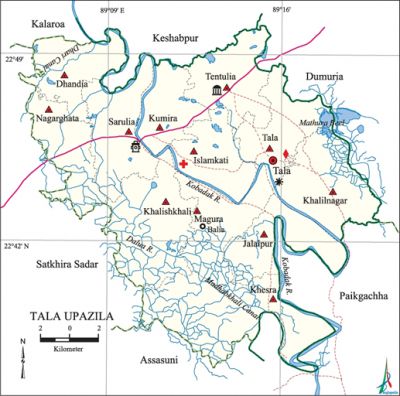Tala Upazila
Tala Upazila (satkhira district) area 344.15 sq km, located in between 22°32' and 22°50' north latitudes and in between 89°05' and 89°20' east longitudes. It is bounded by kalaroa, keshabpur and dumuria upazilas on the north, assasuni upazila on the south, Dumuria and paikgachha upazilas on the east, satkhira sadar upazila on the west.
Population Total 294400; male 152017, female 142383; Muslim 212029, Hindu 79867, Buddhist 2143 and others 361.
Water bodies Main rivers: kobadak, Dalua; Madhabkhali Canal, Dhari Canal and Mathura' Beel is notable.
Administration Tala Thana was formed in 1913 and it was turned into an upazila in 1989.
| Upazila | ||||||||
| Municipality | Union | Mouza | Village | Population | Density (per sq km) | Literacy rate (%) | ||
| Urban | Rural | Urban | Rural | |||||
|
- |
12 |
150 |
230 |
8635 |
285765 |
855 |
64.62 |
45.07 |
| Upazila Town | |||||
|
Area (sq km) |
Mouza |
Population
|
Density (per sq km)
|
Literacy rate (%) | |
|
6.61 |
4 |
8635 |
1306 |
64.62 | |
| Union | ||||
| Name of union and GO code | Area (acre) | Population | Literacy rate (%) | |
| Male | Female | |||
|
Islamkati 15 |
5304 |
10078
|
9476
|
50.13
|
|
Kumira 55
|
4686
|
12051
|
11303
|
46.18
|
|
Khalilnagar 31
|
7946
|
14276
|
13384
|
42.47
|
|
Khalishkhali 39
|
9057
|
13596
|
12635
|
44.19
|
|
Khesra 47
|
11723
|
13197
|
12406
|
44.66
|
|
Jalalpur 23
|
5917
|
11494
|
11007
|
44.67
|
|
Tala 87
|
6115
|
16209
|
15372
|
51.46
|
|
Tentulia 94
|
6540
|
11916
|
11491
|
40.42
|
|
Dhandia 07
|
5796
|
10854
|
10026
|
40.43
|
|
Nagarghata 71
|
6229
|
9136
|
8598
|
39.11
|
|
Magura 63
|
6811
|
10552
|
9823
|
46.61
|
|
Sarulia 79
|
6752
|
18658 |
16862 |
51.87 |
Source Bangladesh Population Census 2001, Bangladesh Bureau of Statistics.

Archaeological heritage and relics Tentulia Jami Mosque.
Historical events The anushilan samiti was formed in 1902 with the initiatives of Gayenandranath Basu, Sree Aurobindo and Promathnath Mitra. In 1905 intensive movement began under Raj Kumar Basu against the annulment of the Partition of Bengal. On 16 August 1909 the Anushilan Samiti, under its Secretary Shachin Mitra, conducted a robbery at the residence of Mathur Poddar of village Nangla under this upazila. A peasant conference was held under the chairmanship of peasant leader Sudha Roy in 1944 at the playground of Kumira High School.
Religious institutions Tentulia Jami Mosque is most notable.
Literacy rate and educational institutions Average literacy 45.66%; male 51.85%, female 39.08%. Educational institutions: college 12, secondary school 60, primary school 119, madrasa 21. Noted educational institutions: Tala Government College (1969), Kumira Mohila Degree College (1993), Baliadaha KMMC Institution (1899), Tala B Dey Government High School (1888), Kumira Multilateral High School (1902), KMMC Secondary High School, Dhandia Union Institution (1915), Khalishkhali Shaiva Girls' Secondary School (1928), Islamkati Girls' Secondary School (1929), Patkelghata Qaumi' Madrasa (1960).
Cultural organisations Library 16, club 60, cinema hall 3, theatre stage 1, theatre group 1, women's organisation 71.
Main sources of income Agriculture 70.34%, non-agricultural laborer 2.67%, industry 1.30%, commerce 13.17%, transport and communication 3.02%, service 4.21%, construction 0.85%, religious service 0.25%, rent and remittance 0.15% and others 4.04%.
Ownership of agricultural land Landowner 65.80%, landless 34.20%; agricultural landowner: urban 65.84% and rural 65.80%.
Main crops Paddy, wheat, jute, mustard, potato, gram, onion, lentil, turmeric, vegetables.
Extinct or nearly extinct crops Tobacco, linseed, kaun, coriander.
Main fruits Mango, jackfruit, coconut, betel nut, litchi, papaya, plum, guava, banana, blackberry.
Communication facilities Pucca road 84.19 km, semi-pucca road 31.73 km, mud road 621.15 km.
Extinct or nearly extinct traditional transport Palanquin, horse carriage, bullock cart.
Noted manufactories Rice mill, oil mill.
Cottage industries Goldsmith, blacksmith, potteries, weaving, handicraft, mat work, reeds work.
Hats, bazars and fairs Hats and bazars are 12, fairs 4, most noted of which are Patkelghata Hat, Khalishkhali Hat, Dalua Hat, Tala Hat, Jethua Hat, Jatpur Hat, Kumira Hat, Magura Hat, Melekbari Hat, Balia Hat, Kathipara Hat and seven day long Durga Puja Mela.
Main exports Paddy, jute, wheat, potato.
Access to electricity All the unions of the upazila are under rural electrification net-work. However 24.09% of the dwelling households have access to electricity.
Sources of drinking water Tube-well 92.90%, tap 1.08%, pond 0.52% and others 4%.
Sanitation 31.15% (rural 29.37% and urban 89.86%) of dwelling households of the upazila use sanitary latrines and 41.17% (rural 42.35% and urban 2.36%) of dwelling households use non-sanitary latrines; 27.68% of households do not have latrine facilities.
Health centres Upazila health complex 1, union family welfare centre 32, community clinic 36, clinic 4, charitable dispensary 2.
NGO activities Operationally important NGOs are brac, asa. [Ashraful Islam Goldar]
References Bangladesh Population Census 2001, Bangladesh Bureau of Statistics; Cultural survey report of Tala Upazila 2007.
